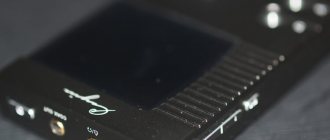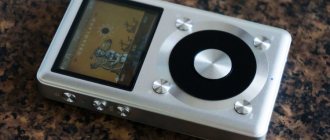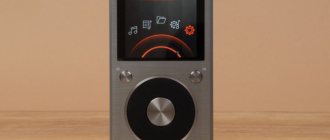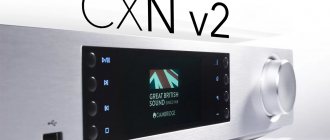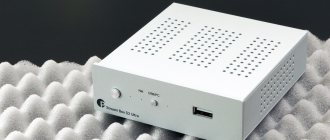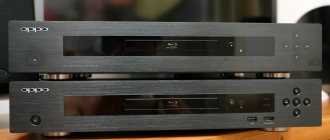In modern society, with its established tradition of overconsumption, it is impossible to produce one product for a long time and feel confident (unless, of course, you are Hoegaarden Brewery). The personal audio market is no exception; the “run ahead or die” principle is also fully operational here. Therefore, FiiO did not delay and updated its flagship X7.
As often happens, the company did not do anything super new; the main burden of innovation this year fell on the third generation of the X5, which, not without reason, collected a lot of prestigious design awards. After looking at this achievement of the X5-3, FiiO decided that the new X7 also needed such a side panel. Mark 2 received it. I'll tell you about the change in design in the appropriate section, but for now let's talk about the filling. The player still uses the 4-core RK3188; the processor, of course, is not the newest, but more than sufficient for portable players. To help him cope with hardships and adversities, FiiO added RAM to the device, increasing the total volume to 2 GB. To please audiophiles, the DAC was updated to the Pro version of the ESS Saber 9028, a third master oscillator was also added, now DSD, frequencies multiples of 44.1 kHz and 48 kHz are clocked independently. We slightly increased the battery capacity (to level out the gluttony of a more modern DAC) and added support for Quick Charge. For owners of huge collections, they made support for a second memory slot, which, combined with 64 GB “on board,” gives a very impressive amount of storage. The internal layout with shielding has also been redesigned, improving protection against interference when operating wireless modules.
They also took into account complaints about the AM1 and, in the spirit of the fashion trend “not a day without a balance,” equipped the X7 Mk2 out of the box with a special version of the AM3A balanced amplifier with reduced power (which benefited both power consumption and noise).
They didn’t increase the price, the player in the USA is still sold for the same $650, but I don’t know how much it will cost from our distributors (the only thing that can be said for sure is that it will be more expensive from official sellers ).
Specifications
- Processor: 4-core RK3188 @ 1.4 GHz
- RAM: 2 GB
- DAC: ESS9028 PRO
- Op-amp: 2 × OPA1612 + 2 × OPA926
- OS: Android 5.5.1
- WiFi: 802.11 b/g/n (with 5 GHz support)
- Bluetooth: Bluetooth V4.1, APT-X
- Screen: 3.97″, IPS TFT, 480 × 800, 16.8M colors
- Built-in memory: 64 GB (user accessible ~55 GB)
- External memory: 2 × MicroSD up to 256 GB
- Input: MicroUSB (Support QuickCharge, USB DAC, Dock)
- Outputs: linear, optical and coaxial S/PDIF
- Complete amplifier outputs: 3.5 mm and 2.5 mm balanced
- Battery: 3800 mAh
- Charging time: up to 2.5 hours with regular adapter, less than 100 minutes with QC
- Operating time (approximate): about 8 hours from regular AM3A output, about 7 from balanced
- Support lossless formats: APE, ALAC, AIFF, FLAC, WMA
- Support lossy formats: MP3, AAC, WMA, OGG
- Support DSD: DSD64/128 (ISO, DSF, DFF), DXD: 352.8 kHz
- Dimensions: 128.7 mm × 67.2 mm × 15.5 mm
- Weight: 212 g
Line output
- Frequency range: 5Hz~70kHz(–3dB)
- Total harmonic distortion + noise: <0.0008% @ 1 kHz
- Channel Separation: ≥103 @ 1KHz
- Signal to noise ratio: ≥119 dB
- Dynamic range: >114 dB
- Voltage: >1.8 Vrms
3.5mm output
- Frequency range: 6Hz~60kHz(–3dB)
- Total harmonic distortion + noise: <0.003% @ 1 kHz
- Channel Separation: ≥73 @ 1KHz
- Signal to noise ratio: ≥116dB
- Output impedance: <1.2Ω
- Voltage: >6 Vp-p
- Power: ≥150mW @ 32Ω, ≥17mW @ 300Ω
Balanced output
- Frequency range: 6Hz~60kHz(–3dB)
- Total harmonic distortion + noise: <0.003% @ 1 kHz
- Channel Separation: ≥97 @ 1KHz
- Signal to noise ratio: ≥119 dB
- Output impedance: <1.7Ω
- Voltage: >10 Vp-p
- Power: ≥400mW @ 32Ω, ≥63mW @ 300Ω
Packaging and delivery
FiiO learned how to make boxes 5 years ago. Of course, there are no wooden boxes or plywood covered with dermantine here. Traditional black cardboard of the main box and a black “dust jacket” with minimalist printing. Inside, immediately under the cover, there is the player itself, and on a layer below are the complete accessories. The kit includes:
- Screwdriver for changing amplifiers
- Spare screws
- Alternative side trim for amplifiers
- Adapter for coaxial output
- MicroUSB cable
- Silicone case, immediately put on the player
- Black leatherette case with red threads
Also, right at the factory, a protective glass was glued onto the player’s screen (for which I thank the manufacturer, I always glue it unevenly and with bubbles).
In general, the package is more than good, but don’t forget about the accessories: dock, remote control, K5 amplifier and everything else - this is a nice plus of the player. By the way, the kit included a booklet with an advertisement for all this goodness, for some reason also mentioning the F1 and F3 headphones, although they are clearly not a pair of X7-2.
Sound with a capital letter. As expected
Despite the fact that among the waste paper included with the player there is an advertisement for FiiO F1 and F3 headphones, I chose to test the new FiiO F9, which are the first hybrid in-ear headphones of this company.
In the F9 headphones, a dynamic emitter is responsible for the low-frequency range, and two emitters with a balanced armature are responsible for the mid and high frequencies.
Thanks to the clear frequency separation and comfortable mounting, these headphones, at their cost, are almost the best in terms of price-quality ratio today, and there is no shame in purchasing them in pair with the most sophisticated Hi-Fi players.
Master track: Pink – Beautiful Trauma .
After several days of testing, I can confidently say that the FiiO X7 II player is the most honest player in terms of balance and overall panorama. Low frequencies do not protrude forward, but are felt with elastic shocks even without experimenting with the equalizer and effects.
Master track: Cheap Trick – You Got it Going On .
The player delivers mid frequencies practically without any emotions, you listen to the track in the form in which the sound engineer intended it. However, if you slightly change the equalizer settings, you can get goosebumps from guitar riffs, and slam and mosh pit no longer seem such scary words.
Master track: Weezer – Mexican Fender .
The player plays the upper frequency range no worse than more expensive portable Hi-Fi gadgets. Since the player's feature is honesty, at first it may seem that the highs are too forward. But in truth, the detail of high frequencies, together with others, benefits the overall perception of music.
Design
The main design change can be seen in the photographs; the left panel now has the same edge as the X5-3 with a track navigation rocker, a volume wheel and a play/pause button. Also noticeable is the “moving” of the power button to the top edge and the addition of a branded red ring around it (FiiO decided to think about its own identity). In fact, the design changes go a little deeper, giving the second-generation X7 a more “grown-up” look. Gone are the protrusions on the front and rear panels that distinguished the first generation, the screen is now made almost flush with the body. The logo has disappeared from the front panel (a step that not all “big players” dare to take), the memory card slots are made with trays, and this looks much more solid. If we add to this a high-quality build (including good button clicks, a non-wobbly wheel with a high-quality encoder) and fit, then FiiO can now be compared with top-tier players. Let's see how the model behaves over several months of use, but, for example, on my A&K AK320 the volume wheel works a little worse than on this player.
Of the controls that I did not mention above, there is also a universal jack on the top panel (optical has been added to the linear and coaxial outputs) and connectors on the amplifier module (regular and balanced). There is also a MicroUSB connector at the bottom. Of course, in our age of rapid development of USB-C, I would like to see it, but this standard does not allow you to output everything necessary for the operation of branded docking stations, so you have to use an 11-pin MicroUSB compatible with the standard one.
Perhaps the second generation X7 is for me the ultimate size pocket device. If it were even a little larger, it would be unrealistic to carry it in your jeans pocket, but the player fits in there with a little difficulty, but it still fits in there. The new asymmetrical design adds ergonomics to the device (with the first generation of the player, it was sometimes forgotten what the buttons on each side were responsible for). Immediately the device itself takes a comfortable position in the hand, and the fingers immediately fall on the control buttons.
Of course, the second revision retained compatibility with the amplification modules of the first model. To visually link them with the new side panel, the developers made the part of the protrusion that fits the amplifier removable. This solution made it possible to kill both birds with one stone - both design and backward compatible. If you plan to use the X7-2 with the K5, the thin version of the attachment included in the kit is at your service, with it the player will dock without any problems.
If you compare the new product with the X5-3, it looks more catchy - absolutely right angles, interesting texture of the front and rear panels, black color - all this makes it more “wow-effective”. The steel “titanium” color of the X7-2 makes the device look more discreet, just as a suit often emphasizes a person’s social status.
I can’t help but note the presence of the QuickCharge function. In my measurements with MEEAudio Pinnacle P1 as a load, the player worked for 8 hours 10 minutes from the normal output and 7 hours 5 minutes from the balanced output. The result is not a record, but this is the price of using a “full-fledged” 9028 in a non-mobile version. Thus, the ability to charge the player in an hour and a half to 100% becomes a very useful addition to functionality.
A familiar player in a new wrapper
Among all the updates to the X7 II, the first thing that catches your eye is the new multifunctional wheel - it can be programmed to rewind tracks or adjust the volume.
The power button has moved to the top end of the device and acquired a glowing “ring” that clearly shows the player’s operating status.
The overall visual impression is that the player has become more “grown-up”: there are no logos or angularities on the front panel, the device has become more grippy, and all controls can be comfortably reached with the fingers of one hand.
The body of the X7 II is made of aluminum, but to touch it you will have to remove the silicone case, which is immediately put on the device out of the box.
Yes, in terms of equipment, FiiO is, as always, at its best: in addition to the silicone one, in the box you can also find a hard leather case, trimmed with red thread. I recommend using it – it looks expensive and rich.
At the bottom end of the player, in the advanced version of the pre-installed amplifier module ESS Saber 9028, there are balanced and 3.5 mm outputs familiar to Hi-Fi devices.
If this is not enough, at the top end there is also a universal jack for linear, balanced and coaxial connections, which belongs to a special version of the AM3A balanced amplifier.
This amplifier, in addition to its characteristics, is characterized by reduced power consumption.
It is clear that the player can be used both for listening to music and as an external DAC, for example, with a computer.
By the way, on the left side of the player the creators placed as many as two trays for memory cards. So now, given the built-in memory of 64 GB, there should be no problems at all with storing your favorite albums.
Firmware
Of course, the main work of control falls on the touch screen (it has been slightly improved, the resolution remains the same, but the contrast, brightness margin and viewing angles have increased). Below the screen there is still a smoothly blinking indicator strip, which can also still be turned off in the menu.
Android, as before, works as the operating system, but since the release of the first generation X7 its version has grown to 5.1.1 (the story was long and difficult). FiiO develop firmware for all three of their Android models on a common code base, so they are functionally close, and bugs are fixed for all at once.
Of course, Android is not an ideal operating system in terms of battery saving and stability, but today it is the only way to seamlessly support streaming and functions like USB-OTG. Therefore, I am 99 percent sure that the future of portable audio lies with this OS (except for the most inexpensive solutions).
The X7 Mark II, like its predecessors, has two modes - Android and Pure Music, but the only difference between them is that in the latter the player application replaces the OS launcher, thus removing it from the user's eyes (but not from the device's memory). ) unnecessary applications.
Of course, the player application, simply called FiiO Music, is the central element of the firmware, and the company understands this. For the X5-3, the ability to automatically update the player without upgrading the entire firmware is already being tested; soon other models will receive this function, which will allow the program to be updated more often.
FiiO Music for X7-2 received a new light theme, which gave the firmware a feeling of freshness, but in general the functionality is already familiar to those who have used the company's players with Android OS.
Immediately after launch (the loading of the player is slightly faster and takes 44 seconds), the user is greeted by a familiar screen. At the top is the cover of the current album; tapping on it opens the playback screen. Below are three buttons: playlists, media library and DLNA. Traditionally, the media library allows you to view tracks in a complete list, by album, artist, genre or folder. Swiping on a track/folder allows you to perform various operations such as deleting them. There is also a convenient search (here it is, plus touch input).
Let's go back to the main screen. Below the library buttons on the main screen are lists of the most popular, recently added, and recently played tracks. In the upper left corner there is a button with a gear; clicking on it opens a panel of basic player settings (scanning your media library, choosing a theme, lock screen and a number of other options). You can immediately change the topic if you got bored and decided to see what the very first firmware of the previous X7 looked like. At the bottom of the list are the effects from VIPER. As before, some of them are free, some cost as much as 50 cents apiece, but for those who like to “tweak the sound” this is still an interesting option. By the way, the lock screen with full-size album cover is very good. Another cool feature of the player is automatic downloading of covers and lyrics over Wi-Fi.
As expected, some of the settings are placed in a “curtain” that can be opened by swiping from the top edge of the screen. There are switches for Wi-Fi, Bluetooth, mode reboot (Android/Pure Music) and a number of other options.
Naturally, there is also a third place with settings; the Android settings panel, familiar to almost everyone, offers both standard options such as clock and input language, and unusual ones: choosing one of 7 filters supported by the 9028, channel balance and performance mode. The latter, by the way, is an innovation. You can choose between Balanced mode, which provides better battery life, and Accelerated mode, designed for playing the largest DSD files and other less useful formats.
The playback screen is quite minimalistic, with all advanced options hidden behind a button in the lower right corner that opens a menu. Here you can delete a track, add it to a playlist, adjust the equalizer (traditionally, it’s best not to), or view information about it. Tapping on the screen allows you to switch display modes: album cover, brief information about the track, song lyrics or a nice VU meter. A little-known feature - swiping from the left edge opens a panel with tracks included in the current playlist.
In general, the firmware has been greatly improved in recent years in terms of speed and stability, I did not notice any major bugs or lags. Of course, there will definitely be some bugs in it, especially when working with third-party software, but this is the price for “full-fledged Android” on board; the only alternative to it can be strictly functionally limited firmware a la A&K and theBit.
I almost never switch to Android mode, but among the positive changes it is worth noting the integration of Google Play and the Google Services necessary for most programs.
In general, describing the functions of the software can take a long time, but I don’t set myself the goal of writing a textbook “FiiO X7 Mark II for dummies” - the firmware is quite simple, so you can figure it out in a couple of hours, and I’ve already written more than 11,000 signs, but didn't get to the main one. It's time to move on.
Sound
The following headphones were used to listen to the device: iBasso IT03, Meze 99 Classics, Audio Zenith PMx2, Noble Kaiser Encore, Campfire Audio Andromeda, 64 Audio U12, HUM Pristine and others.
The main “claims” that were put forward to the first generation FiiO X7 in terms of sound were due to the standard AM1 amplifier module. The company took this into account and equipped the player with a balanced AM3A. The “original” AM3 is noticeably power hungry and noisy with sensitive headphones, so FiiO reduced its power, successfully reducing the impact of both problems. The user still has the entire range of amplifiers from the company (including my favorite AM2), but here we will talk about the stock configuration. The overall presentation of the X7 is still neutral without being too dry.
The bass of this player is neutral, without any attempt at emphasis. It is supplied without the much-loved pumping, which creates a “mass” effect, so for those who like increased pressure in the bottom region (sounds like a euphemism), the neutral AM3A will not be suitable, and in general it is better to immediately look at other players. The strong point of the X7 Mark II is reliability, control and texture, however, when necessary, the player copes well with delivering the required amounts of bass without any visible problems, there is no need to talk about lightness here (except by the standards of those who have hopelessly ruined their hearing and taste with bassheading). Of course, deep low frequencies are also present and played out without problems; this part of the range is a noticeable improvement compared to the first generation X7.
The mid-frequency range is also tuned towards impartiality, the player tries to play everything as it is, without smoothing or adding emotions. On the other hand, the novelty avoids sliding into dry monitoriness, balancing somewhere between these edges. Of course, we are not talking about the total impartiality of the DX200, but the X7 Mark II also makes high demands on the material, since you will hear exactly what is recorded, and, like any truth, this knowledge is not always pleasing. However, buying an expensive player and listening to bad recordings on it is generally a so-so idea, but in this case, for those “who want something strange” there is a kind and humane AM2A module... I got distracted. The X7 Mark II is good at constructing an imaginary scene; it is not huge, but clearly does not suffer from constriction, and this applies to both depth and width. On some tracks, the vocalist moves a little forward, which adds impact to the presentation. If we talk “in general”, then the conveyance of the character of the instruments is reliable, as well as the emotionality of high-quality recorded tracks, so on good recordings the player sounds very involving.
The high-frequency range is another area besides the deep low frequencies where the influence of the new DAC (and possibly master oscillators) is especially noticeable. The player copes well with practicing attacks and with the resolution of the high-frequency range, the length has also improved. Attenuation is a little blurry, and the overall “layering” of the treble lags behind the top models, but this is not very noticeable without a direct comparison with something in the ≥$1000 category. Naturally, the player will not be suitable for those who do not like high frequencies; the player makes no attempts to hide anything or specifically soften it, which generally benefits its neutral presentation.
Of course, this review will not be complete without comparisons. This time I will limit myself only to Android models and only those that I have in stock; writing such sections “from memory” is an unpromising task.
FiiO X7 first generation . Of course, this is the first and main comparison. I compared these players on the same amplifiers, using AM2 and AM3A. I can immediately say that the difference is not huge, but clearly audible. The second generation works better on the bass, especially the lower registers; the Mark II has better speed and texture transfer. The high frequencies also sound noticeably better - both attacks and length have improved. In general, if you already own a first-generation player, there is no point in rushing to upgrade it urgently; the update here is still evolutionary, not revolutionary. If you are just looking at the FiiO flagships, then I advise you to still overpay for the Mk2, the total increase in sound and a lot of pleasant improvements in hardware are worth it.
FiiO X5-3 . As I wrote above, the younger model, perhaps, looks more impressive, and the more pocket-sized form factor speaks in its favor. If you compare the sound, there will be different approaches to building the sound. The “Five” plays more smoothly, with a pleasant touch of darkness and smooth, comfortable highs. “Seven”, as befits a flagship, does not try to change anything in the presentation, but, on the contrary, strives to play more neutrally, as if removing itself from the final result.
iBasso DX200 . Compared to AMP1. Naturally, the DX200 plays better - punchier bass, more developed highs, the difference is not huge, but it is there. On the other hand, it is worth noting that the DX200 is even more critical to the quality of recordings, is larger in size (for me, the X7 is still included in the category of pocket devices, but the DX200 is no longer), and is more expensive. So you need to choose based on whether sound is the main thing for you, and how high-quality material you listen to.
Functionality, OS
FiiO X7 runs Android 4.4.4 OS. They did not load the shell with unnecessary functions and left it basic - it works quickly, no complaints. Additionally, a simple shell is available that launches only the proprietary music player.
The market in the player on the first versions of the firmware was only from FiiO, after the update the classic Google Play appeared. The vast majority of applications work on the latest firmware - you can run Trials Frontier without any problems.
The X7 runs on a 4-core Rockchip RK3188 processor, has 1 GB of RAM and 32 built-in memory, supports memory cards up to 128 GB. You can use the player as an external DAC for a computer with support for 384 kHz / 64 bit format.
The amplifier block is removable, there are no alternatives on sale yet, but we hope that they will appear soon. Wi-Fi and Bluetooth modules are also available, which made me very happy. You can listen to music from the network, external wireless drives, the cloud, home library, etc. There are a lot of possibilities. In fact, we have an iPod touch, only on Android and with Hi-Fi sound.
Compatibility
The AM3A's power reserves are sufficient for the vast majority of reasonable applications. But this is precisely the advantage of a modular design; whatever you want - huge power or, conversely, something weak but long-lasting - you can get it. Therefore, the player can be adapted to almost any headphone model.
Stylistically, the new seven is quite universal, provided, of course, that the owner prefers a neutral presentation. In general, with players of this level, it is better to obtain the desired coloration of the sound using headphones. The player is quite critical when it comes to recording quality, about 8 out of 10.
Traditional sample tracks
Dolores O'Riordan - Human Spirit . The beautiful singer with a difficult-to-pronounce surname is familiar to us primarily as the performer of the hit “Zombie.” Dolores' solo career reveals her more lyrical side, and, as is often the case with ex-rock performers, the track is quite restrained in form, but in essence this restraint hides a subtle emotional game that only a technical source like X7-2 can reveal.
Green Day - Wake Me Up When September Ends . Just like the title says, September is over and it's time to wake up. Wake up and pay tribute to the pop-punk legend. Perhaps not since the heyday of Billy Idol has there been a band that so convincingly blends the rebellion of punk with the glamor of pop music. Green Day are precise in every step, starting with the pathetic tear-jerking video and ending with the impeccable quality of the recording. It was the last factor that allowed me to take this track into the selection; the flagship from FiiO plays it energetically, forcing me to simply immerse myself in the track.
Diane Coffee - Poor Man Dan . Well, and, perhaps, another pop track, this time - a very interesting version of Californian pop, full of psychedelic effects, in some places it even sounds something from the classic Abbey Road. Behind the rustic appearance lies a very dense and rich melody, which the hero of today’s review helps you hear in its entirety.
Damn he's good
The updated X3 turned out to be very decent, although it is not too different from the previous generation of this audio player. FiiO engineers have set themselves the main task of creating a device that will outperform many of its colleagues in sound, but at the same time remain familiar to users of players of previous generations. It’s hardly advisable to replace the X3 II with the X3 Mark III, but it’s definitely worth considering the new product as an upgrade from a budget model (and especially as the first Hi-Res player).
conclusions
Very often, in reviews of FiiO products, parallels with Apple arise. Both companies are clearly among the leaders in their market segment, both in terms of sales and solutions. Both companies are subject to active, but often inadequate criticism, which, however, does not prevent them from setting record after record. Both companies are trying to develop their line evolutionarily, which they are quite successful at. Returning specifically to the X7 Mark II - once again we have one of the strongest players in its segment, not without its shortcomings, but more than compensating for them with its advantages.
I don't want X7. I want X7 II
As a result, FiiO released one of the best players for both seasoned audiophiles and newcomers to the world of Hi-Fi music. Minor improvements, external and internal, clearly benefited the device, but the price has remained virtually unchanged, which is good news.
The only caveat for bass lovers is that this player will most likely disappoint you. Or maybe, on the contrary, it will make you happy - listening to this player you feel as if some kind of veil is falling away: many tracks of various genres sound so clear that it’s unusual to even listen to them.
However, this purity is the charm of the new X7 II.
( 2 votes, overall rating: 5.00 out of 5)

